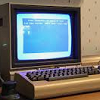My name is Michel de Rooij, and I’m a Microsoft 365 Apps & Services MVP from The Netherlands. I help organizations in their cloud journey, where my focus lies on Identity and Messaging, especially in the Microsoft domain. This translates to Microsoft Exchange, (Azure) Active Directory, and Teams. I am a big enthusiast of automation, so automating tasks or creating tools supporting project activities using PowerShell is also something I love doing.
Background
Before my bachelor’s study, I worked for a few demo groups for the Commodore C64, where I took up graphics, music, and coding. That would come down to writing in assembly language for the Intel 6502 processor, the famous MOS 6581 SID chip for audio, and the MOS VIC-II 6569 chip for video. Assembler language is not easy and has a high learning curve, but it is what you need to use if you want to get the most out of the machine’s capabilities or even beyond its specifications.

At the end of my C64 period, the Commodore Amiga came up. When starting my bachelor’s study in Computer Science, I got an Amiga 500. PCs were expensive at that time, and Amiga would allow not only for gaming but also gave the option to run a (albeit slow) software-only PC emulator called Transformer, which I could use for school projects that required compilers such as Borland’s Turbo Pascal/C++. For transport, I used a 5¼” drive attached to the Amiga, as those disks were cheaper but also could be used to exchange files with systems at the university). As usage for study became more important, at some point, I got my initial PC with an Intel 386SX, 2MB memory, a monochrome VGA display, and 80MB(!) SCSI drive. I also got some hands-on experience creating applications using dBase III+ and Clipper, for example, to catalog my CD collection.
void print_route( word start, word end) {
word i= end, stack[ nr_nodes], j= 0;
printf( "\n* Shortest path: ");
while( i != start) {
stack[ j]= i;
j++;
i= node_info[ i].tonode;
}
stack[ j]= i;
i= j;
while( stack[ i] != end) {
printf( "%s *> ", node_name[ stack[ i]]);
i--;
}
printf( "%s\n", node_name[ stack[ i]]);
}
After my bachelor’s study, I started my professional career as a 3/4GL developer. Back then, this meant coding in dBase III+/4, Clipper, FoxPro, and, in the end, PowerBuilder. I worked on several applications for data processing, but over time became more interested in working with infrastructure technology. At some point, I got the opportunity to work with Microsoft Exchange for a large multinational organization during a project, and made the professional switch at that point.
Since then, I have worked on many projects for many enterprise organizations, ranging from migrations to designing infrastructure architecture. Since 2004, my work experience has mainly been related to exchange and related products and technologies. Over time, related workloads of Microsoft 365 were mastered as well. The source platform is not always Microsoft, so the usual Notes, GMail or Zimbra migration also came by.
A developer background is a big asset in modern infrastructure-related projects, as they assume scripting (PowerShell) knowledge and a certain thought process for breaking down work and integrating solutions.
EighTwOne
What’s with this name, EighTwOne? I had to make up a name as all the name variations on mail, exchange, and ehlo had already been taken. So, I used the original RFC number for SMTP, which was RFC 821, and wrote that down eight two one. Then I noticed overlapping letters between the words, so I left them out, keeping only 1 letter, putting it in uppercase for readability.
So, in short:
RFC 821 => eight two one => EightTwoOne => EighTwOne
Mystery solved 😀

Logo
Recently, I changed the site logo from the cheesy ‘cloud’ logo many other sites use in some shape or form, replacing it with initials from Exchange, Outlook/Office 365, and Teams icons. The PowerShell icon completes the set because of the code samples and scripts you can find here.
So, as a mnemonic:
- E is for Exchange is for Eight
- T is for Teams is for Two
- O is for Outlook or Office 365 is for One
Example NamesOn a final note: In case you are wondering where names such as Philip Mortimer, Francis Blake, or Olrik, which make an appearance in many examples, come from, I took them from the comics series Blake and Mortimer, created by the late Edgar P. Jacobs.


![c60332f7-c611-494f-9b39-e80604e5a445[1]](https://eightwone.files.wordpress.com/2013/02/c60332f7-c611-494f-9b39-e80604e5a4451-e1360759887241.jpg)
Pretty Neat Michel – Logic for 821 🙂 !
Cheers
Nitin
LikeLike
Pingback: Exchange 2010 Reference Material | Lynn Lunik - Chief Security Architect
Pingback: All Exchange 2010 network communications in a diagram « Bhargav's IT Playground
Hi Michel,
I like your blog – I added it to the blogroll section on mine :).
Keep up the good work.
Clint
LikeLike
Incredible site
LikeLike
this looks great keep it up – even better would be a list of known regressions that are introduced by RUs and SPs
LikeLike
Still use your site (allmost) weekly! Keep up the good work!
LikeLike
Thanks!
LikeLike
Great Collection of Tools. Thank you!
LikeLike
821 mystery solved. Whenever I say your site name I remember the martial art “taekwondo”
Keep up your good work Michel. I learned a lot from your blog.
LikeLike
eight two one you are the best!
LikeLike